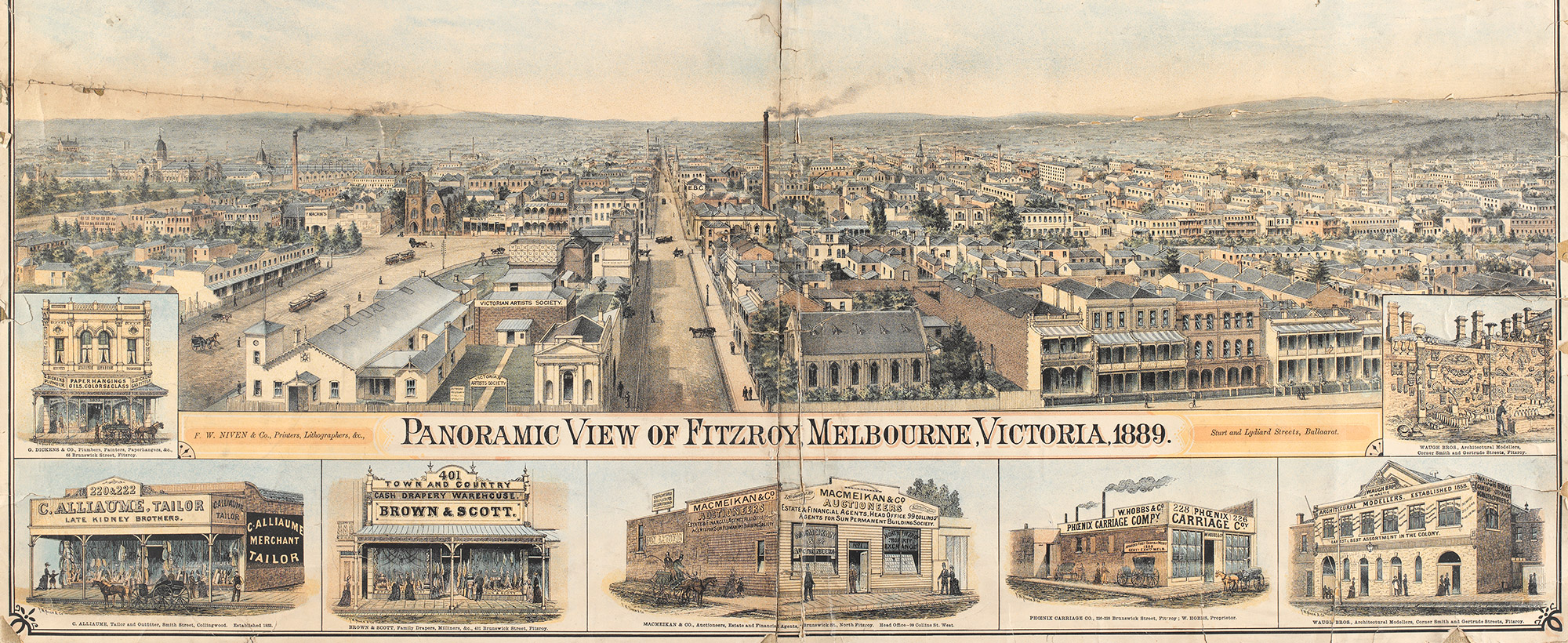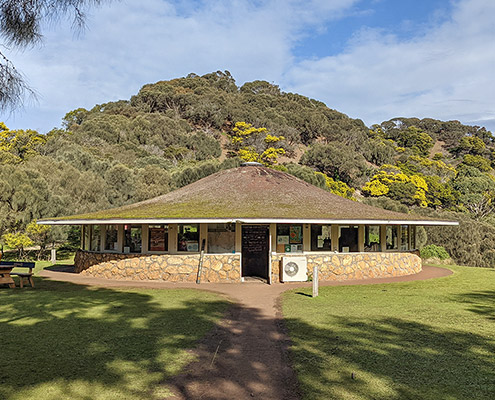


St Vincent’s Private Hospital is located on the lands of the Wurundjeri-Willum people of the Kulin nations
Two significant heritage buildings that form part of the St Vincent’s Private Hospital complex are the focus of a fascinating interpretation narrative that reflects the continuing importance of this corner of Melbourne’s Fitzroy to the broader community.
The first building is the Eastern Hill Hotel (formerly Belvidere Hotel), designed by Joseph Burns, erected in 1854-55 (remodelled 1866-76) and noted for its elegant Renaissance Revival facades. It occupies the corner of Victoria Parade and Brunswick Street, and was one of the largest 1850s Gold Rush pubs in Melbourne. This was the headquarters of the Eight Hours Movement in 1856. The building is socially significant for the number of its women publicans, and for its 1979s-80s role as a music venue featuring Aboriginal bands.
Construction of the second building, Edensor on Brunswick Street, began around 1865 on the site of the birthplace of the first Australian-born Catholic saint, Mary Ellen McKillop. It was sold to the hospital in 1927 and its name changed to Dodgshun House, which is how it it known today. The site has other associations besides St Mary of the Cross — including politician and Lord Mayor of Melbourne Sir Samuel Gillot — and been home to Eye & Ear Hospital nurses. An archaeological dig revealed the foundations of Como Villa (constructed c.1858) and the torsos of “Frozen Charlotte Dolls” (see below).
Fitzroy is located on Wurundjeri-Willum country. The development of material and approach for the implementation of the interpretation plan has involved a wide-ranging consultation process that included engagement with the elders of the traditional owners. We also consulted sources written by the indigenous community. St Vincent’s did a workshop and consultation with the Little Sisters of St Joseph, and we later met with senior nuns who gave us feedback, recommendations and their thoughts.
A key aim of the interpretation plan for these two sites is to give people a way to connect to them as more than a hospital — to conserve the textual narrative for the two heritage buildings. Plaques have be installed at strategic locations, with straightforward content: some of the topics are outlined below. There is also documentation for the archaeological work carried out by Terra Culture. An old plaque from a former Aboriginal health centre has been reinstated.
EASTERN HILL HOTEL
— Headquarters of the Eight Hours Movement
On 1 March 1856, local bricklayers met here and resolved to join the stonemasons in their efforts to push for an eight-hour working day. The two groups joined forces and the hotel became the headquarters of the movement demanding an eight-hour workday supported by eight hours of rest and eight hours of recreation. The Eight Hours Movement achieved progressive success for workers from 1856, although some still worked longer days into the twentieth century.
— Women publicans
Between 1928 and 1970, most of the leaseholders and licensees of the hotel were women. They included Katherine Roper, Christina Hoban, her cousin Alice Monaghan, Amelia May Dick, Marjorie Stirling, Mary Sertori and Margaret Whitty. Just as the hotel was a local landmark, its publicans were an active presence in the Fitzroy community.
— Aboriginal Fitzroy
Fitzroy has long been recognised as a social and political focus for Aboriginal Melbourne. By the 1860s, the Wurundjeri-Willum had suffered nearly complete dispossession of their lands and many were relocated to missions and reserves. In the 1920s, as that system broke down, Aboriginal families began to re-establish roots in Fitzroy. The area developed into a thriving Aboriginal community and the centre of growing political activism — the Aboriginal Church of Christ, the Aborigines Advancement League, the Victorian Aboriginal Health Service, the Victorian Aboriginal Legal Service and the Fitzroy Stars Football Club are examples of the many Aboriginal organisations that emerged.
EDENSOR
— One House Many Lives
There have been at least three residences on this site: Marino Cottage (1840s), Como Villa (c.1858) and Edensor (first built c.1866). The latter was commissioned by Samuel Gillott — lawyer, property investor, Lord Mayor of Melbourne during Federation, and a minister in successive state governments. However, in 1906 he was accused of turning a blind eye to illegal gambling and having financial dealings with brothel owner Caroline Pohl aka ‘Madame Brussels’. The house was purchased by the Eye & Ear Hospital in 1927 and adapted for use as a nurses’ residence — frequently hosting fetes, fundraisers, parties, exhibitions and performances — and remained in use by nurses until the 1980s.
— Mary of the Cross Centre
Marino Cottage was briefly owned by Alexander MacKillop and is where his daughter Mary, later St Mary of the Cross, was born. The Roman Catholic Diocese acquired the site in 2000 and in 2001, the main house became a support centre for families suffering from the effects of drug and alcohol abuse.
— Excavating Como Villa
Como Villa replaced Marino Cottage in 1858 and was constructed in brick for Robert Downing. It had at least five rooms and a basement. The house was acquired by Samuel Gillott (see above) in 1872 and demolished c.1899 for expansion of Edensor. An archaeological excavation of the basement and remaining of foundations of Como Villa was completed in July 2021, and many interesting items were found, including torsos and limbs from hand-painted porcelain “Frozen Charlotte Dolls”. A popular toy, they were manufactured between 1850-1920, based on a ballad titled Fair Charlotte and a poem by Seba Smith, A Corpse Going to a Ball.
Heritage data
constructed 1854-55 (Eastern Hill Hotel), c1865 (Edensor)
original architect Joseph Burns (Eastern Hill Hotel)
victorian heritage register H 0816 (Eastern Hill Hotel), H 1706 (Edensor)
headline photo : Panoramic view of Fitzroy, Melbourne, Victoria 1889 (detail), courtesy State Library of Victoria
Belvidere Hotel c1863 : photo Charles Nettleton
other photos : courtesy State Library of Victoria
archaeology and finds photos : courtesy TerraCulture
SELECTED REPORTS HELD
full list : see REPORTS INDEX
77 Victoria Parade, Fitzroy — Former Eastern Hill Hotel : conservation management plan
Lovell Chen / OCTOBER 2012 : CONSERVATION MANAGEMENT PLAN
Edensor, 7-9 Brunswick Street, Fitzroy : conservation management plan
Lovell Chen / JULY 2016 : CONSERVATION MANAGEMENT PLAN
More Civic buildings all projects >

 NEWS / Wattle Park CMP
NEWS / Wattle Park CMP